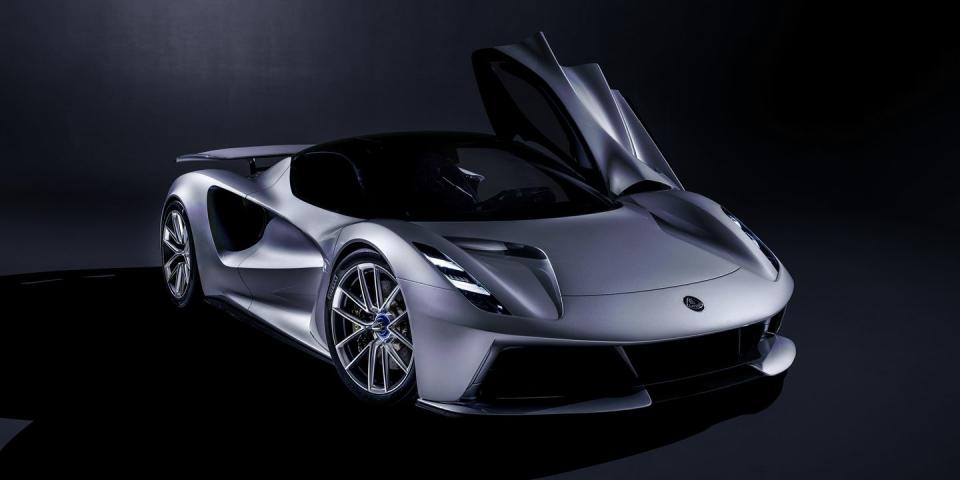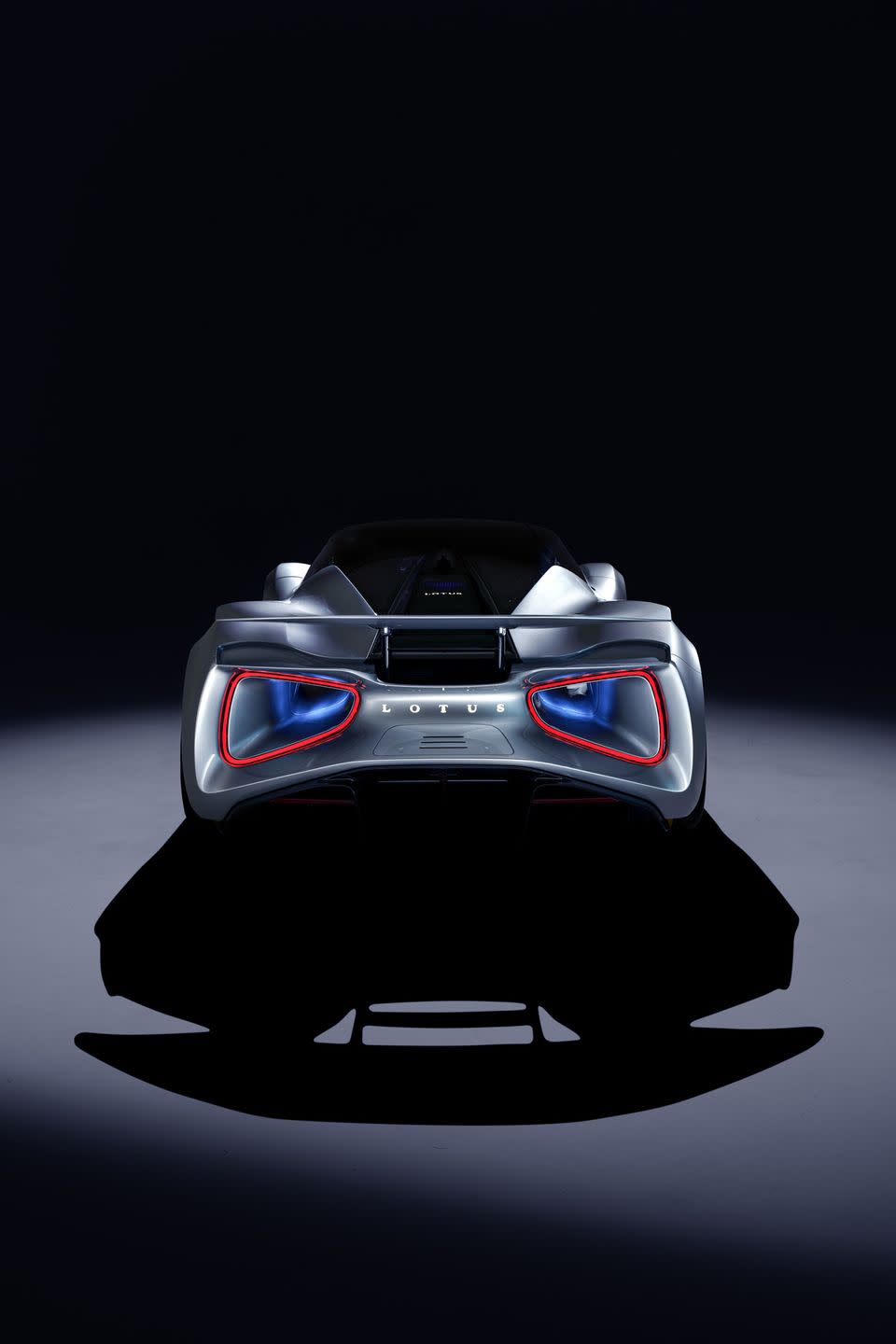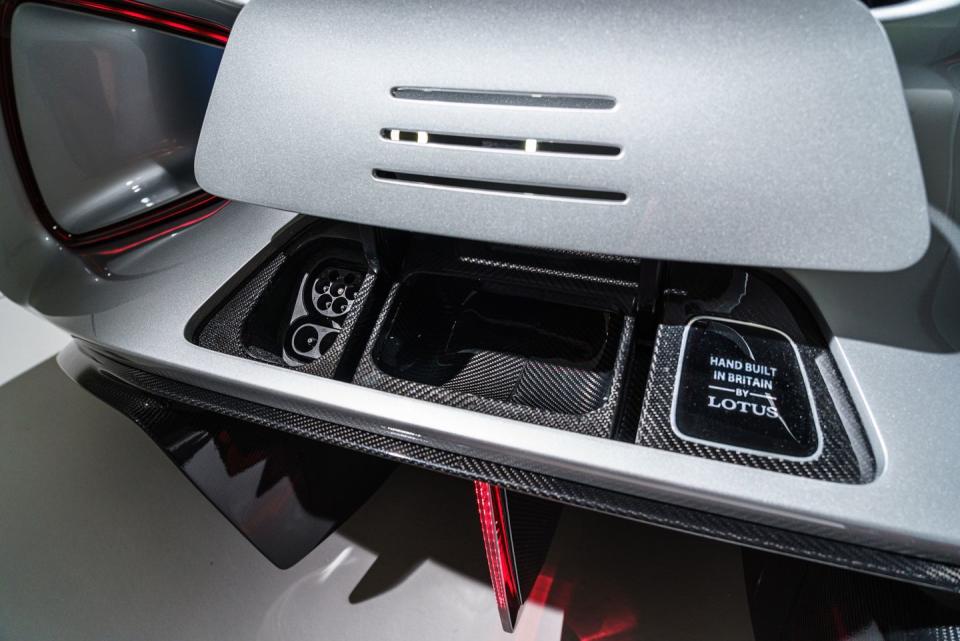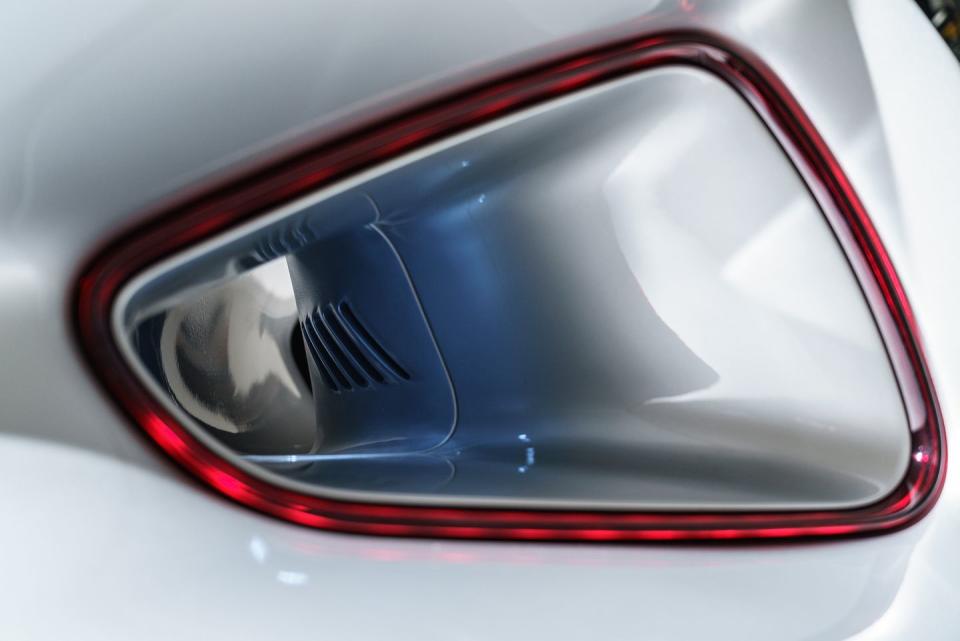The Lotus Evija Is Britain's 2000-Horsepower Hyper EV

While we patiently wait for whatever bigger and more complex cars are bound to replace the Elise and Exige lines, the team at Lotus's focus has been the Evija, an insanely powerful electric hypercar initially known as Type 130.
This article was originally published on 8/16/2019. It has been updated with photos from the car’s London debut.
With a Williams-engineered 70 kWh battery pack and a target output close to 2000 horsepower, this four-wheel drive EV weighing 3700 lbs. is not only a huge step for the brand in terms of design and technology, but also what seems like a radical departure from Colin Chapman's "simplify, then add lightness" mantra, a philosophy the Hethel factory undoubtably lived by up until now. And while Lotus says that the Evija is still the lightest car in its segment, one could argue that only Geely's investment-heavy takeover could push Lotus towards creating a product with 1253 foot pounds of torque, and a price tag in the $2.5 million region.
But before we'd get into all the gadgets Lotus will give you for your massive pile of money, scroll through the images above, and imagine Lotus Design Director Russell Carr standing right next to you with the car. Talking from experience, he would sum up the Evija like this:
Lotus is all about the driving dynamics, and you want the car to look agile and athletic. Another Lotus trait is aerodynamics, so on this car, we have an interesting way of managing air flow. We’re not the first to do it, but we’ve done it in an interesting way. Which is not just managing the air flow over the top surfaces of the car and underneath, but also through the car. If you look (at the front), it’s all completely open, so that allows the air to go into the wheel arch and evacuate at high velocity at the rear. That reduces drag, and on this car, we want minimum drag, maximum downforce, and so, huge amounts of CFD (computational fluid dynamics) work was done. The front splitter and above is not a simple surface, it’s multiple aero elements. And I like how you can see the car as a whole, but then it reveals some interesting technical things. It’s really important for us to balance form and function, or as Cadillac used to say “art and science”, because that’s Lotus. You can see it on the beautiful Type 25 we put on display. A very technical solution, yet a beautiful car. And it’s what we want to do, beautiful cars, really. Not doing things just to shock. I should say as well, this openness, the aerodynamicist call it porosity, or transparency. But we also wanted to make the car look sculptured, a little bit different from some of the more brutal, maybe track-focused cars. Something that is purposeful, but also elegant as well. We have almost aerospace shapes, and we used aeronautical things as our influence. You know how all car designers have aircraft on their walls, and then sometimes, you wonder where that message was lost when they did a boxy SUV. On this car, it makes sense. This car is all about carving through the air, with the minimum amount of drag. Creating downforce is just the opposite of creating lift. Around the front, some nice detailing as well, like the little wing forms for the daily running lights, so you get two sort of warrior-like stripes at the front. But then you got the latest technology in there, laser units, so very lightweight, very efficient. Other nice jewelry details at the front as well. The badge, carbon fiber, like the whole car with the carbon tub, but all the metalwork is inlayed, in precious metals. So it can be titanium, but you could have silver, gold, whatever you fancy. If you move around the car, classic Lotus wheel housing. I grew up with Matt Becker, our former handling guru, insisting on these high points so you could position the car on track. So we call these ‘Becker points”. As you see, no door mirrors, because we got cameras with screens inside, so again, reducing drag with technology. At the back, you start seeing some of that openness. If you stand just behind the door, you see a lot of tire. It’s there to extract air. Then you see where the air rolls off the canopy, as the line goes around the car. And then we got some really crazy surface sculpture that helps lighten the car, but also gives it muscularity. And then you start building towards the big story. So, a big intake, but it’s not a traditional intake with a radiator. This is a tunnel the aerodynamicist call a rear-quarter Venturi, and then that leads on to the killer view of the car, which is from the rear.

First of all, this view is everything you want from a sports car. It’s wide, it’s muscular, the cabin is hunkered down, and the car looks like it’s got a low center of gravity. It looks like it’s gonna go around corners. Big diffuser, DRS, and the exit vents of those Venturis, which are just awesome pieces of sculpture. I was lucky enough to go through a glacier last year in Iceland, and it’s a bit like looking inside that. And then, of course the lights. Completely unique, nobody has done this before, round the tunnels. A bit like afterburners on fighter planes. The ’T’ in Lotus is the reversing light, and I’m hoping it’s strong enough to act like the Bat signal, projecting light on the clouds. But I don’t think it’s gonna work like that. And then post-factory, you can switch this all on, so LOTUS gets illuminated. But it’s not a homologizable thing. The car is very clever, because it has a lot of passive aero, but we’ve got active parts as well. The active wing, DRS flaps. Behind the cover, we have the charging point, with a nice little reminder: “Hand built in Britain”. And that’s quite an important thing as well. Earlier on, we were thinking: What is British luxury, what is Lotus luxury? Well, it isn’t about ornamentation. If you think what’s Britain well known for…it’s quite well known for aerospace technology, satellites and wings, and motorsport. But on the other side, hand-crafted things. If you can combine the two, maybe with a little bit of humor in there, you get something that’s very British, but isn’t Bentley or Rolls-Royce. Because they do being Bentley and Rolls-Royce really-really well. Obviously, we haven’t got a conventional engine in here, so how do you bring the emotion back into the car? We want technology with soul. You can see all the suspension units from the top, as well as the battery pack and the inverter. The high-voltage cables, a bit like looking at manifolds.

And when it comes the interior, you again get this sense of openness, this transparency. The dashboard is not conventional, it’s not solid. It makes a nice reference to cars I like, classic race cars of the fifties and sixties. Like the Maserati Birdcage, where you see the whole structure. But this is all carbon fiber, beautiful wing-shaped section, which is very Lotus in that it does more than one job. It’s an instrument panel, but it’s also a structure to hold the column, and it’s also where all the ducting for the air goes. The interior is a really driver-focused environment, all the surfaces in the cabin wrap around you. All the controls are intuitively laid out, so you’re not distracted while driving. One screen, latest LED technology. Through that screen, you got speed, range, navigation, music and telephone. And you interact with it through a control wheel on the center console, so it’s very safe to use. Other controls on the steering wheel, and where possible, we made the controls have a mechanical feel to them as well, like on a classic camera. Frankly, we have a very motorsport-inspired steering wheel. We are very lucky at Lotus. Our development guru, Gavin Kershaw spent hours and hours developing various OEMs’ cars. He has driven all the best hypercars, and is a successful racing driver, so he helped with what’s the best practice in all those areas. The center panel, the touch surface for secondary controls have a hexagonal pattern, so we could nest little recessed switches, so when you put your hand in there, you can feel where the switch is. It’s not just a dead flat screen, you know. But the whole interior theme is minimal, but not raw. It’s not a racing car. Very light, but luxurious in a Lotus way. We got very high quality materials, carbon fiber, and in this car, leather and Nubuck. Machined parts in titanium or aluminum. It’s all about the forms and materials. The seats, big pieces of carbon fiber, but thickly padded. It’s not like sitting on bare carbon. In the center of the seat, there’s a metal inlay strip, which is customizable with text, or whatever the customer has in mind. Family motto, or something rude, maybe? I don’t know. Mixing materials is a common there. There’s also mood lighting running around, just to wrap around you, and a bit of storage. In the doors, and a hidden one in the sills, which deploys a carbon fiber case.
Lotus calls the Evija "the world's most powerful production car", and on paper, the claim stands. This Lotus uses a powertrain co-developed with Williams Advanced Engineering, with a target output just shy of 2000 horsepower. And this much juice puts the British EV on pair with the Rimac C_Two and Pininfarina Battista, with the Evija also packing four-wheel drive with torque vectoring, active aero, and three inboard adaptive spool-valve dampers per axle, made by the motorsport aces at Multimatic. Hello, Ford GT Mk II!

Lotus says that thanks to the 70 kWh lithium-ion battery pack's power output of 2000 kW, the Evija will reach 186mph in under nine seconds, after blasting to sixty in sub three. It's also a 200+ mile an hour affair, yet unlike most battery electric vehicles, Lotus' hypercar doesn't use a floor-mounted battery pack. Instead, the cells and inverters are mid-mounted behind the driver. Lotus says this layout delivers "significant advantages in terms of styling, aerodynamics, packaging, weight distribution, occupant comfort and dynamic handling", while also allowing for easy servicing, maintenance, and possibly battery upgrades in the future. No word on center of gravity.
Either way, the power goes to a pair of e-motors on each axle supplied by Integral Powertrain Ltd., which feature integrated silicon carbide inverters and epicyclic transmissions. These four single-speed, helical gear ground planetary gearboxes transfer power to each driveshaft, which come from the Dakar champions at Xtrac. Measuring a mere 100mm in depth, each gearbox comes packaged with the e-motor and inverter as a single cylindrical Electrical Drive Unit, with a target output of 500 PS (492 horsepower) per motor. Which isn't too shabby. With this much power and torque sent through a four-wheel drive, a sophisticated torque-vectoring system is standard, while steering remains electro-hydraulic, because feel.
Once you've had enough fun to run out of voltage, you'll appreciate what Lotus claims to be the world's fastest charging battery. Using its know-how gained through Formula E and other semi-secret projects, Williams Advanced Engineering came up with a battery pack that can accept an 800kW charge. Such a charger is not available yet commercially, but once your local fast-charger network operator gets there, the Evija will be able to fully replenish its cells in nine minutes. Basically, while you finish your coffee.
Hooked onto an already accessible 350kW unit through the CCS2 socket hidden behind the vented flap at the rear, the Evija’s charge time will be 12 minutes to 80 percent, and 18 to full. Lotus is aiming for a range of 250 miles, which would make the Evija more than usable in daily traffic. In case that's what you fancy.

The backbone of the whole thing, the Evija's carbon fibre monocoque chassis is supplied by CPC of Modena. It weighs only 284 lbs., and under it, the 20 (front) and 21-inch (rear) wheels are made of magnesium, shot with Pirelli Trofeo R tires, McLaren Senna-style. The brake discs are carbon ceramics, heated up by AP Racing's forged aluminum pistons. Additionally, you have the air brake for the heat of those electrifying track days.
Last but not least, just in case Russell Carr's illuminated Venturi tunnels or the glowing brakes granted by the Evija's 3700 lbs. mass aren't enough to get you noticed, Lotus threw in laser headlights as well. The Osram units are the world's first in that they use laser beams for both main and high-beams. Audi only uses lasers for its high-beams, wherever it's legal to do so. The Lotus Evija then: most power, fastest charging, and lasers!

Only 130 people will be lucky enough to own Lotus' first completely new car in decades, a $2.3+ million electric vehicle with a build slot deposit of $315,000, otherwise known as the price of three well-loaded Lotus Evoras. Lotus says that it will be available for purchase globally, though in America it'll be a case of getting a car in via the Show or Display regulations.
We'll just have to deal with this, because at the end of the day, the Evija looks radical, it's full of interesting technologies, and if a heavy hypercar aimed at new-wave collectors is not really your cup of tea, the latest Evora will still be there to deliver the goods only a Lotus can. And deliver, it will.

You Might Also Like
